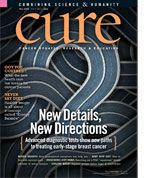A Gift of Knowledge
Evolving from science project to living hope
I am one of the first people who survived rhabdomyosarcoma as a child to make it to adulthood. I know because it says so on the Internet in an article that summarized the findings of several doctors who took part in the clinical trial I joined in 1970 when I was 9 years old.
The trial was designed to see if surgery, combination chemotherapy, and radiation would be effective in treating rhabdomyosarcoma, the most common pediatric soft tissue cancer. It can occur in the head and neck, genitourinary tract, and arms and legs. Mine was in the soft tissue of my right sinus and under my right eye.
According to the article, by 1972 only nine children out of 20 were still alive. I was one of them.
I knew I was the third child successfully treated at M.D. Anderson Cancer Center in Houston, but I was astounded when I learned that I was one out of nine nationwide.
Then I flipped through a book about survivors. Again, my jaw dropped. The treatment that was pioneered on the nine of us between 1967 and 1970 is still in use today. It seems amazing, and yet this is a reminder that someone had to go first in the great unknown we call the fight against cancer. While there was only a 25 percent survival rate when I was diagnosed, today it’s more like 70 percent.
I had grown up feeling like a science project. On each trip back to Anderson from my home in Austin, Texas, a gathering of doctors examined me and said things that were the medical equivalent of “Hot damn! This is way cool!” They thumped me like a watermelon as specific body parts were examined to learn how the treatment had affected them.
Learn was the operative word, because our bodies had become teaching tools. I was only a child, but I knew I was taking part in a great experiment. Anderson was a teaching hospital, so doctors came from all over the world to learn how to treat cancer.
Two other girls had been treated at Anderson three years before I was. They were living hope for me when I was worn out and wondering what would come next. I knew that what had been learned from treating them had been passed down to me. Knowledge was passed from one person to the other in a hand-to-hand gift as we moved closer to a cure for rhabdomyosarcoma.
I tried to picture all the children who came after us passing a gift of knowledge from one to the other.
I wondered who would come after me.
Three years later, I learned her name was Allison. I wondered how the information gleaned from my treatment was able to make her treatment less harsh. I tried to picture all the children who came after us passing a gift of knowledge from one to the other.
As an adult, I seldom saw children in treatment. Once in a blue moon, I’d be in the pediatric clinic to see the long-term follow-up doctor. On one of these occasions, I met a little boy who asked me if I had a son or daughter in treatment. I told him I was a survivor of rhabdomyosarcoma. His eyes got big, and he said, “My sister has that!” Soon there was a bald, skinny little girl pushing her wheelchair over to me. We talked for a long time, and I did my best to assure her that if I could get through it, so could she.
I understood how important it was to know that someone else in the world had made it to the other side, and I wanted to be her living hope.
